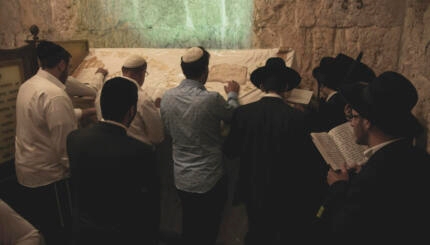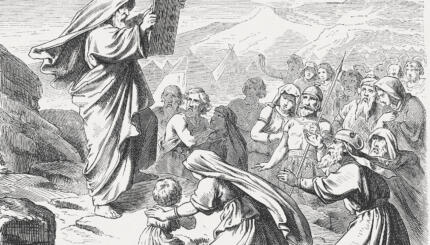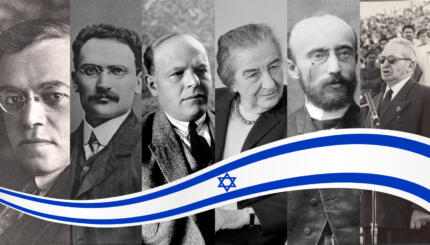For millenia, Jewish thought concerning the Land of Israel was the job of theologians. But after Israeli independence in 1948, practical political thought about the Land became much more important than abstract theological musings. The following article looks at secular Zionism since 1948.
Before the state of Israel was created, secular Zionism consisted of political and cultural variants. The transition from ideal to reality that accompanied statehood posed serious challenges to both these notions.
Secular political Zionists pursued the dream of reestablishing Jewish sovereignty in the Land of Israel through political means. Cultural Zionism strove to establish the new Jewish state on the basis of a revived Hebrew culture. Labor-socialist Zionism combined political and cultural elements, attempting to merge Jewish nationalism with an egalitarian, collectivist ideology that emphasized the value of labor, agriculture, and social justice.
 Labor Zionism’s strong emphasis on institution building enabled it to establish ideological and cultural dominance in the pre-statehood period and continue its reign through the first 30 years of statehood. These institutions–which included the collective settlements (
im), the semi-collective settlements (moshavim), the labor union and workers cooperatives (histadrut), and the sick fund (kupat hulim)–became the foundations of the new socialist-leaning state of Israel.
Labor Zionism’s strong emphasis on institution building enabled it to establish ideological and cultural dominance in the pre-statehood period and continue its reign through the first 30 years of statehood. These institutions–which included the collective settlements (
im), the semi-collective settlements (moshavim), the labor union and workers cooperatives (histadrut), and the sick fund (kupat hulim)–became the foundations of the new socialist-leaning state of Israel.

Help us keep Jewish knowledge accessible to millions of people around the world.
Your donation to My Jewish Learning fuels endless journeys of Jewish discovery. With your help, My Jewish Learning can continue to provide nonstop opportunities for learning, connection and growth.
The cultural goals of labor Zionism were advanced through the institutions such as the Davar and Al Hamishmar newspapers, publishing houses of the kibbutz movement, and hapoel sports clubs.
Splits Within Labor
Within the labor Zionist movement, a small left wing (Mapam) emphasized socialism as the economic and social building block of the new country and favored one state for Jews and Arabs in Palestine. A larger right wing (Mapai) favored developing Israel according to social-democratic lines and campaigned for a distinctly Jewish state, even at the price of reduced territorial boundaries.
The dominant Mapai party–led by David Ben-Gurion, Beryl Katznelson, Sharret, Pinchas Lavon, and Pinchas Sapir–gradually developed a pro-American and pro-Western foreign policy for Israel.
Mapam–led by Meir Yaari, Victor Shem Tov, and Hazan–advocated initially for a pro-Soviet line, which became more difficult to support with the mounting evidence of Stalinist atrocities and anti-Semitism.
Secular Political Zionism
Secular political Zionism achieved a great victory with the establishment of the state of Israel in 1948. Ironically, it was this great success that raised deep questions about the future of the movement.
If the focus of pre-state Zionism was simply the establishment and securing of Jewish sovereignty, it was without a purpose after 1948. The major state-building efforts of the Zionist movement–self-defense, settlement, and immigrant absorption–were now performed by the young government.
Consequently, many argued that political Zionism had run its course. David Ben Gurion, the first Israeli prime minister, argued that the term “Zionism” was now devoid of meaning. He sought to bolster Israel’s strength not by alliances with the various Diaspora Zionist parties, but rather with Jewish philanthropists, who supported Israel while remaining indifferent to Zionist politics.
In the first three decades of the state’s existence, Israel faced three overriding political issues: setting up the government, defining the nation’s borders, and formulating a societal character. On each of these, the dominant tone was set by labor Zionism. The smaller right-wing parties, the moderate liberals, and the more hawkish Herut Party, led by Menachem Begin, advocated minority positions. In opposition to Labor, the right-wing parties advocated for a less welfare-oriented government; supported territorial expansion; and articulated a vision of Israeli society influenced by Jewish tradition, the cultural heritage of Middle Eastern Jews, and conservative values.
Arabs in Israel
The different streams of Zionism also held opposing positions on the relationship between the Jewish and Arab populations within what became the state of Israel. The right-wing revisionist movement (the forerunner to the Likud)–led by Ze’ev Jabotinsky–accurately identified early Arab hostility to Zionism as nascent nationalism but argued that only one national movement could find its expression between the Mediterranean Sea and the Jordan River. Jabotinsky offered Palestinian Arabs full civil rights as individuals under Jewish sovereignty throughout the Land.
The left-wing labor movement initially believed the benefits of socialism and economic and technological progress would transform the Palestinians into allies of Zionism. After 1948, and especially after 1967, left-wing secular Zionism recognized the rights of Israeli Arabs to equality within the state and the rights of the Palestinians in the Gaza Strip and the West Bank to political independence.
The End of Labor’s Hegemony
The Six Day War in 1967 and the War in 1973 were watershed events in the dissipation of Labor’s dominance of Israeli society. The inclusion under Jewish sovereignty of East Jerusalem, Judea, and Samaria–areas that were central to biblical Israel–shifted the focus of settlement and nation building from a secular-labor orientation to a national-religious drive focused on building up the newly acquired areas.
The divide over the future of these territories became the major cleavage within Israeli society. National religious strains of political Zionism gained momentum within Israel. Official Israeli policy after 1977 viewed the large-scale settlement of the territories as a security and policy imperative.
Labor continued to govern the country for a decade after the 1967 war, with a new generation of Israeli-born leaders like Moshe Dayan, Yigal Alon, Rabin, and Shimon Peres posing themselves as Ben-Gurion’s heirs. Their dreams of continued Labor hegemony were shattered with the surprise Arab attacks on Yom Kippur 1973. Although Israel won that war and retained its 1967 territorial gains, the Labor government was increasingly viewed as complacent, arrogant, out of touch with the public, and in some cases, corrupt. In 1977, the face of political secular Zionism was radically transformed with the ascendancy to power of Begin’s Likud block, an alliance of the formerly minority right-wing and centrist parties.
Secular Cultural Zionism
Secular Zionism’s cultural variant also ran into problems after 1948. The close link between religion and nationality in Jewish identity made it difficult to excise religious motifs, symbols, and values from the new collective identity of what aspired to be a Jewish state.
In one telling case, Zionist leaders debated the inclusion of religious language in the Israeli Declaration of Independence. In the end, they compromised by including the words “Rock of Israel,” intended as a reference to the role of God in restoring Jewish sovereignty. This debate is indicative of the difficulty of creating a completely secular culture in Israel.
Dramatic demographic shifts in the population of the new state made this even more difficult. The bulk of Israel’s pre-statehood Jewish population had come from Europe, meaning they had lived for more than 150 years in secular Western nation-states. However, masses of Middle Eastern immigrants flocked to Israel’s shores in the first two decades after independence, bringing with them a traditional Jewish worldview that instinctively linked the return to Israel with a revival of Jewish tradition.
These recently arrived immigrants often felt disenfranchised from shaping the civic culture of the new state. But their children, who came of age in the 1970s, set in motion a political, social, and cultural revolution that reemphasized traditional Jewish imagery and values at the expense of secular Zionists’ dreams of a new secular Hebrew culture divorced from religion. This in no small part contributed to the political revolution of 1977. While cultural creativity in the Hebrew language continues to thrive in Israel, it increasingly integrates religious and traditional imagery.
A Historic Compromise
The complex and volatile political reality of the new state also posed profound difficulties for secular Zionist culture. Upon the inception of statehood, the Labor party and the Orthodox National Religious Party reached a historic compromise, which established that in certain matters Israel would adhere to religious jurisdiction and authority. The status quo this created fell short of establishing Israel as a religious state, while granting religious authorities a great deal of political power in certain areas including marriage and conversion.
Resistance to this power became the identifying feature of the secular Jewish population in Israel. Over the last few decades, secularism in Israel has become associated more with the political battle to weaken the hold of religion in the public sphere than with the creation of new forms of secular Hebrew culture and expression.
Conclusion
A look at the decades since Israeli independence highlights the significant accomplishments of secular Zionism in both of its variants. With all of its failings, secular Zionism has established a modern country with a full spectrum of dynamic economic, technological, social, political, educational and cultural institutions. It has revived the Hebrew language and generated a cultural revival of Jewish expression and creativity.
Secular Zionism has changed considerably from its labor and socialist roots; today, in the form of an Israeli civic culture linked intimately to Jewish tradition and roots, it remains the orientation of the bulk of Israeli society.


